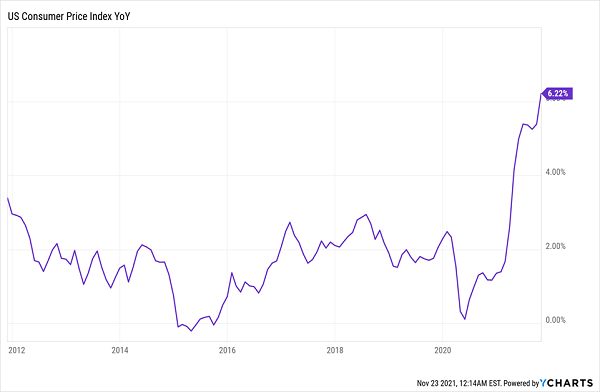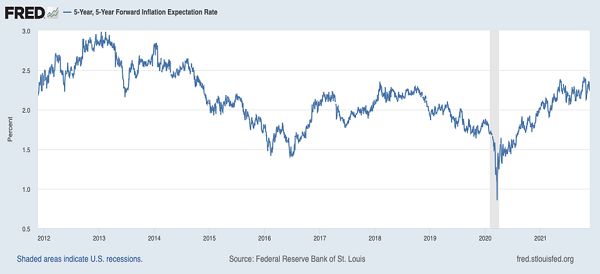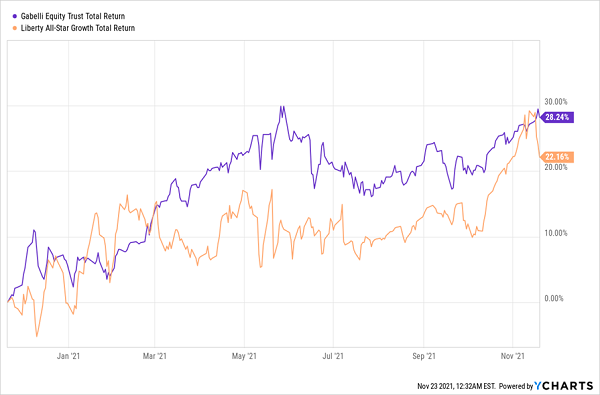Another day, another sign the first-level crowd is (wrongly!) losing its head over inflation—and yet another opportunity for us to tap those fears for big dividends!
Let’s start with the number the headline-focused crowd can’t move past: 6.2%, which is the jump consumer prices took in October 2021, compared to a year earlier.
Inflation Lurches Higher …
 But something strange is going on here—the stock market doesn’t care. While we’ve been hearing about inflation pretty much all year, the S&P 500 still jumped 25% in 2021. That’s because, while the “dumb money” panicked and sold out at various points during the year, the big institutional players—or the “smart money”—stayed long, and indeed bought more.
But something strange is going on here—the stock market doesn’t care. While we’ve been hearing about inflation pretty much all year, the S&P 500 still jumped 25% in 2021. That’s because, while the “dumb money” panicked and sold out at various points during the year, the big institutional players—or the “smart money”—stayed long, and indeed bought more.
That’s because these pros are looking beyond the CPI to “jedi” inflation indicators like the 5-year forward inflation expectation rate, an important derivative used by economists and investment bankers.
This metric measures the 5-year Treasury and 10-year Treasury markets’ implied inflation rates, which is where the most direct and largest bets on inflation are made by the world’s biggest bond traders (we’re talking trillions of dollars here, much bigger than the stock market). Simply put, this tells us exactly how much inflation to expect over the next five years.
And, well, things look pretty tame.
… Or Does It?
 While it’s true that this market shows inflation exceeding 2% over the next five years, at 2.24%, those expectations are not only tame but actually a bit lower than they were at several points in the early 2010s.
While it’s true that this market shows inflation exceeding 2% over the next five years, at 2.24%, those expectations are not only tame but actually a bit lower than they were at several points in the early 2010s.
In other words, the market is telling us that, yes, inflation will be higher than it was in the last few years, but not by much.
So Now What?
If inflation isn’t as big of a problem as the mainstream press says, what does that mean for markets in 2022?
The biggest takeaway is that 2021’s bull market likely has further to run. Many pockets of the economy are still improving from the pandemic, and this improvement will likely continue. That means successful funds with great portfolios, like the Liberty All-Star Growth Fund (ASG) and Gabelli Equity Trust (GAB), are set to keep providing investors with more profits like these.
2 Big 2021 Winners Beat Back Inflation Fears
 ASG, with its 11% trailing-12-month yield, has a significant weightings toward tech, including top holdings Microsoft (MSFT), Alphabet (GOOGL) and Amazon.com (AMZN) in its top holdings. GAB holds a large slice of its portfolio in equipment and supplies, consumer products and food and beverage companies, as well as industrial stocks.
ASG, with its 11% trailing-12-month yield, has a significant weightings toward tech, including top holdings Microsoft (MSFT), Alphabet (GOOGL) and Amazon.com (AMZN) in its top holdings. GAB holds a large slice of its portfolio in equipment and supplies, consumer products and food and beverage companies, as well as industrial stocks.
Since all of the above sectors are sensitive to rising inflation (and interest rates), they should see stronger returns if our pros are right and inflation isn’t the boogeyman it’s being made out to be. Meantime, these funds’ income streams outrun inflation (even at today’s elevated rate), so you’ve got a nice buffer if consumer prices do run higher for longer than expected.
— Michael Foster
Bankroll Your Golden Years With These 5 Safe Dividends (Yielding Up to 7.8%) [sponsor]
Here’s something else you should know about CEFs: they’re incredibly safe! Of all CEFs that are a decade old or older, 96% have made money over the last 10 years.
And when you drop oil and gas funds, that percentage leaps to 99%!
That’s an incredible statistic, especially when you consider that CEFs offer huge dividends, too: the average CEF yields 7% today—and that’s just the average! Some of these funds kick out safe, steady payouts of 9% and more.
In fact, my top 5 CEFs to buy now yield 6.5%, on average, with the highest payer of the bunch throwing off a gaudy 7.8%. That’s enough to hand you a nice $32,500 yearly income stream on a $500K investment.
PLUS, these 5 CEFs are rare bargains—so much so that I’m forecasting 20% price gains from this 5-fund “mini-portfolio” by this time next year. That would add another $50,000 in gains to your $32,500 in dividends!
Full details on these 5 CEFs are waiting for you now. Click here and I’ll give you all the critical data you need—names, tickers, complete dividend histories, buy-under prices and more.
Source: Contrarian Outlook
